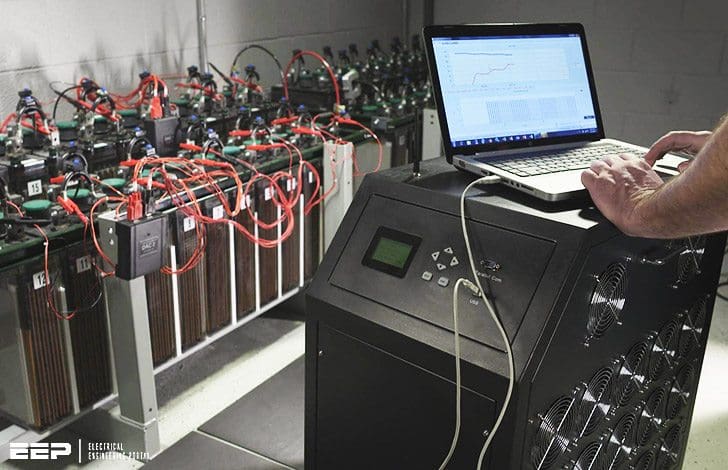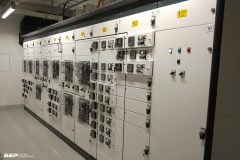Objective
Power substation DC system consists of battery charger and battery. This is to verify the condition of battery and battery charger and commissioning of them.

Test Instruments Required
Following instruments will be used for testing:
- Multimeter. (Learn how to use it)
- Battery loading unit (Torkel-720 (Programma Make) or equivalent.
The Torkel-720is capable of providing a constant current load to the battery under test.
Torkel 720 Battery Load Capacity Tester Front View
Commissionig Test Procedure
1. Battery Charger
- Visual Inspection: The battery charger cleanliness to be verified. Proper cable termination of incoming AC cable and the outgoing DC cable and the cable connection between battery and charger to be ensured. A stable incoming AC supply to the battery charger is also to be ensured.
- Voltage levels in the Float charge mode and the Boost charge mode to be set according to specifications using potentiometer provided.
- Battery low voltage, Mains ‘Off”, charger ‘Off’ etc., conditions are simulated and checked for proper alarm / indication. Thus functional correctness of the battery charger is ensued.
- Charger put in Commissioning mode for duration specified only one time during initial commissioning of the batteries. (By means of enabling switch.)
- Battery charger put in fast charging boost mode and battery set boost charged for the duration specified by the battery manufacturer.
- After the boost charging duration, the battery charger is to be put in float charging (trickle charge) mode for continuous operation.Some chargers automatically switch to float charge mode after the charging current reduces below a certain value.
- Voltage and current values are recorded during the boost charging and float-charging mode.

This test establishes the correct operation of the battery charger within the specified voltage and current levels in various operational modes.
Calculate size of battery bank and inverter – Get MS Excel Spreadsheet!
2. Battery Unit
- Mandatory Condition: The battery set should have been properly charged as per the commissioning instructions of the battery manufacturer for the duration specified.
- Visual Inspection: Cleanliness of battery is checked and the electrolyte level checked as specified on the individual cells. The tightness of cell connections on individual terminals should be ensured.
- The load current, minimum voltage of battery system, ampere-hour, duration etc., is preset in the test equipment using the keypad.For (e.g.) a 58 AH battery set, 5 Hr. duration specification 11.6 A and 5 Hr. duration are set. Minimum voltage setting is = No. of cells x end cell voltage of cells as per manufacturer specification.
- It is to be ensured that the set value of the current and duration is within the discharge capacity of the type of cell used. Also the total power to be dissipated in the load unit should be within the power rating of the battery load kit.
- Individual cell voltages to be recorded before the start of the test.
- Battery charger to be switched off/load MCB in charger to be switched off.
- Loading of the battery to be started at the specified current value.
Individual cell voltages of the battery set are to be recorded every half an hour. - It is to be ensured that all the cell voltages are above the end-cell voltage specified by the manufacturer.
If any of the cell voltages falls below the threshold level specified by the manufacturer, this cell number is to be noted and the cell needs to be replaced. - Test set automatically stops loading after set duration (or) when minimum voltage reached for the battery set.
- Test to be continued until the battery delivers the total AH capacity it is designed for. Value of AH and individual cell voltages to be recorded every half an hour.

Acceptance Limits
This test establishes the AH capacity of battery set at required voltage.
The acceptance limit for the test is to ensure the battery set is capable of supplying the required current at specified DC voltage without breakdown for the required duration.
Resource: Procedures for Testing and Commissioning of Electrical Equipment – Schnedeider Electric












I have 85 cells 110VTX that have been stored for more than 2 years, I want to do the commissioning discharge test , what is the discharge and charge rate?
Sir , Kindly let me know about HV Switchboard Pre-Com & Commissioning and the important factors to be checked .
Regards
Ubaidullah
Love to see this post, thank you so much for sharing this post with us :)
I have to put the batteries (320 Cells in series) on first time charging.
Can I simply select the Boost charge Mode from the key pad and proceed for my testing until the charging current becomes almost zero.
Please let me know if above is not correct.
Thanks,
Javed Akhter
hi Javed Akhter,
my self radhakrishna, generally batteries are designed with highly dielectric materials for storing electrical energy, at time of initial charging of batteries by the boost charger with higher setting the voltage in charger ,ex:(253v for 220v system and 143v for 110v) for full charge the batteries ,if you could set the more voltage like 260v batteries are start the disputed the heat and charging power convert into the heat and release the flame for led batteries,ih this condition battery charging current never become to zero ,even they full charged.
if has any doubt or any service please feel free contact me on [email protected]
contact no:- 91-9014857472
Sir, I would Like to knw Specification of a 120V DC Battery Charger for 12 V 40-50AH SMF type battery
Hi Sir,
I am having some little doubt about calculating the backup time for an UPS system. Can you give some explanation about it ?
thanks for the excellent article – please include the testing format for the dc system